The Design of Frequency Filters of Iterative Feedback Tuning Using Particle Swarm Optimization
Abstract
Iterative feedback tuning (IFT) is a data-based tuning approach that minimizes a quadratic performance index using some closed-loop experimental data. A control weighting coefficient, known as lambda, and two frequency filters are the most important parameters which can significantly improve the performance of the method. One of the major problems in IFT is tuning these parameters. This paper presents a new approach to tune frequency filters using particle swarm optimization (PSO). At the end, the performance of the proposed method is evaluated by two case study simulations.
1. Introduction
Iterative feedback tuning (IFT) is a data-based method for the tuning of controllers with restricted complexity which was proposed by Hjalmarsson et al. [1] in 1994. In this method, the problem of model bias could be avoided by replacing the information carried by the model with information achieved directly from the system itself. This leads to an iterative method where the controller parameters are successively updated using information from closed-loop experiments with the most recent controller in the loop. IFT has proved to be very effective in practice and is now greatly used in process control [2]. Since 1994 many experiences have been achieved by IFT algorithm and lots of improvements have been observed [3–13].
In order to fully take advantage of IFT, a new scheme needs to be introduced to tune the efficient parameters. In earlier studies, the importance of IFT parameters was confirmed and a few tuning key points were presented [8], but the tuning of these parameters has not been treated in much detail. However, some approaches have been proposed to tune similar parameters. Shridhar and Cooper [14] derived an analytical expression in which the suppression coefficients are calculated as a function of the plant model parameters. Kai et al. [15] proposed a min-max algorithm to design tuning parameters. Al-Ghazzawi et al. [16] presented an approach to tuning MPC on-line based on sensitivity equations derived from a step response model with linear constraints.
The IFT’s parameters are mainly a scalar, named lambda, and two frequency filters. This paper provides a method to tune the frequency filters which can emphasize or suppress specific frequency bands of the output and control signals. These filets affect the IFT’s performance greatly. Therefore, convenient design of these filters seems critical. In order to tune these filters, the particle swarm optimization (PSO) is proposed, which tunes frequency filters using the input-output data achieved from IFT algorithm. This method is proposed for the first order filters with two parameters.
The paper is organized as follows: a brief explanation of IFT algorithm is presented in Section 2. In Section 3, the particle swarm optimization method is briefly described and implemented to tune the frequency filters. Consequently, we shed some light on the performance of the proposed method for tuning the frequency filters, by applying the improved IFT to some case study systems in Section 4. Finally, the paper is concluded in Section 5 with a summary of key points and results.
2. Iterative Feedback Tuning Approach
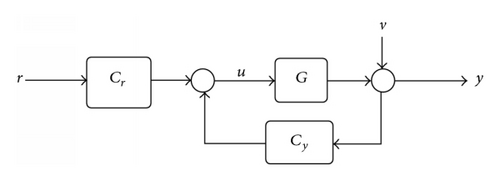
- (i)
emphasizing or suppressing specific frequency bands of the outputs and control signals, for instance, to prevent unwanted oscillations in these signals:
- (ii)
using as notch filters in the frequency bands where the measurement noise dominates;
- (iii)
meeting specific frequency domain performance specifications, such as constraints on the sensitivities.
3. Particle Swarm Optimization
Particle swarm optimization (PSO) is a population-based optimization approach first proposed in 1995 [17, 18]. This method is urged by the observation of social interaction and animal behaviours such as fish schooling and bird flocking [19–21].
4. Simulation Study
Example 1. A gas boiler system is considered where the gas valve position V2 is used to control the temperature T of the water. The following transfer function is used to represent the relationship between the variations in V2 and T when the flow of water is constant [24]:
| Tuning method | K1 | T1 | K2 | T2 | S. T. | Os% | IAE | TV |
|---|---|---|---|---|---|---|---|---|
| Tuned filters | 0.507 | 0.127 | 0.094 | 3.071 | 43.63 | 6.68 | 101.37 | 1.59 |
| Random filters 1 | 0.71 | 0.14 | 0.06 | 3.22 | 41.89 | 29.8 | 114.65 | 3.24 |
| Random filters 2 | 0.59 | 0.12 | 0.13 | 2.93 | 69.32 | 0 | 139.5 | 1.69 |
| Random filters 3 | 0.53 | 0.15 | 0.1 | 2.14 | 125 | 0 | 2.08 | 2.05 |
- S. T.: Settling time.
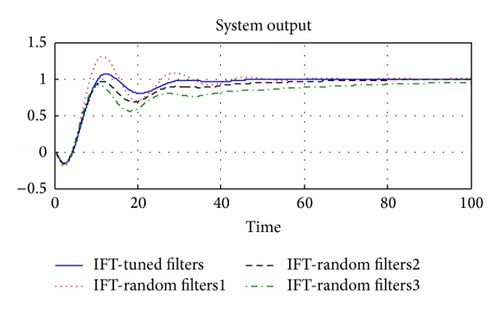
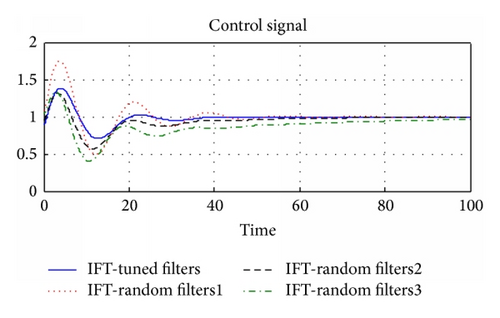
Example 2. Consider the control system of a heated tank. The dynamics relating the control action and the temperature can be modelled with an FOPDT model as follows [24]:
| Tuning method | K1 | T1 | K2 | T2 | S. T. | Os% | IAE | TV |
|---|---|---|---|---|---|---|---|---|
| Tuned filters | 2.321 | 0.91 | 1.1 | 4.52 | 13.021 | 0.458 | 39.21 | 39.33 |
| Random filters 1 | 2 | 0.22 | 1.7 | 2.1 | 33.71 | 98.81 | 96.43 | 5.19 |
| Random filters 2 | 3.16 | 0.22 | 2.2 | 1.9 | 23.88 | 40.33 | 58.84 | 1.66 |
| Random filters 3 | 3 | 0.15 | 1 | 0.83 | 24.75 | 13.098 | 86.81 | 0.3439 |
- S. T.: Settling time.
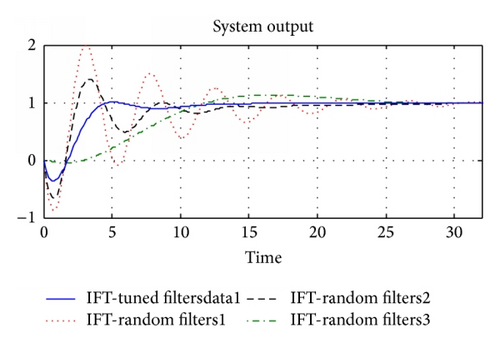
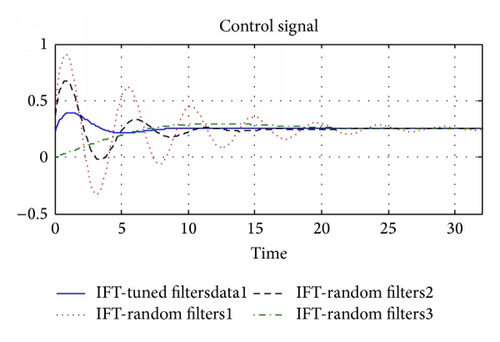
5. Conclusion
The earlier attempts to tune the frequency filters were based on trial-and-error. In this study, these filters were designed using the PSO method. The proposed method was applied to a case study system. It was observed that the performance of IFT modified by the proposed methods was greatly improved. Therefore, IFT has become more capable with a better performance. The proposed method for designing frequency filters in this study is not merely limited to IFT algorithm; therefore, future studies are recommended to generalize the proposed approach to other methods with similar parameters. Also, a further study with focus on high order filters is suggested.
Conflict of Interests
The author declares that there is no conflict of interests regarding the publication of this paper.




